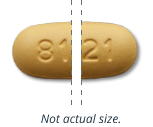
Not actual size.
The smallest darunavir coformulation available2
SYMTUZA® is a complete regimen that is smaller than PREZCOBIX®.2,3
One tablet, once daily with food Taking SYMTUZA® along with food ensures proper absorption.3,4
Dosing

Not actual size.
The smallest darunavir coformulation available2
SYMTUZA® is a complete regimen that is smaller than PREZCOBIX®.2,3
One tablet, once daily with food Taking SYMTUZA® along with food ensures proper absorption.3,4

If desired, patients have the option to split pill into 2 pieces
The whole dose should be taken immediately after splitting.
When splitting SYMTUZA®, a standard tablet splitter may be used.3
SYMTUZA® is a four-drug fixed-dose combination product containing 800 mg of darunavir (DRV), 150 mg of cobicistat (COBI), 200 mg of emtricitabine (FTC), and 10 mg of tenofovir alafenamide (TAF).
The recommended dosage of SYMTUZA® is one tablet taken orally once daily with food in adults and pediatric patients weighing at least 40 kg. For patients who are unable to swallow the whole tablet, SYMTUZA® may be split into 2 pieces using a tablet splitter, and the entire dose should be consumed immediately after splitting.
SYMTUZA® is not recommended in patients with creatinine clearance below 30 mL per minute.
SYMTUZA® is not recommended during pregnancy because of substantially lower exposures of darunavir and cobicistat during the second and third trimesters.
SYMTUZA® should not be initiated in pregnant individuals. An alternative regimen is recommended for those who become pregnant during therapy with SYMTUZA®.
Prior to or when initiating SYMTUZA®, and during treatment with SYMTUZA®, on a clinically appropriate schedule, assess serum creatinine, estimated creatinine clearance, urine glucose, and urine protein in all patients. In patients with chronic kidney disease, also assess serum phosphorus.
SYMTUZA® is not recommended for use in patients with severe hepatic impairment (Child-Pugh Class C).
The safety and effectiveness of SYMTUZA® have not been established and is not recommended in pediatric patients weighing less than 40 kg.
The Centers for Disease Control and Prevention recommends that HIV-infected mothers in the United States must not breastfeed their infants to avoid risking postnatal transmission of HIV-1 infection.
Each SYMTUZA® tablet contains darunavir ethanolate equivalent to 800 mg of darunavir, 150 mg of cobicistat, 200 mg of emtricitabine (FTC), and tenofovir alafenamide fumarate equivalent to 10 mg of tenofovir alafenamide (TAF). The yellow to yellowish-brown capsule-shaped, film-coated tablet is debossed with “8121” on one side and “JG” on other side.
Darunavir and cobicistat are both inhibitors of the cytochrome P450 3A (CYP3A) isoform. SYMTUZA® should not be coadministered with medicinal products that are highly dependent on CYP3A for clearance and for which increased plasma concentrations are associated with serious and/or life-threatening events.
Darunavir and cobicistat are both substrates of the cytochrome P450 3A (CYP3A) isoform. Coadministration of SYMTUZA® with CYP3A inducers is expected to lower plasma concentrations of darunavir and cobicistat which may lead to loss of efficacy of darunavir and development of resistance.
These recommendations are based on drug interaction trials conducted with the components of SYMTUZA®, as individual agents or in combination, or are predicted interactions. No drug interaction trials have been performed with SYMTUZA® or with all the components administered together.3
| Examples of drugs that are contraindicated3 | |
|---|---|
| Alpha 1-adrenoreceptor antagonist | alfuzosin |
| Anticonvulsants | carbamazepine, phenobarbital, phenytoin |
| Antigout | colchicine in patients with renal and/or hepatic impairment |
| Antimycobacterial | rifampin |
| Antipsychotics | lurasidone, pimozide |
| Cardiac disorders | dronedarone, ivabradine, ranolazine |
| Ergot derivatives | dihydroergotamine, ergotamine, methylergonovine |
| Hepatitis C direct-acting antivirals | elbasvir/grazoprevir |
| Herbal product | St. John’s wort (Hypericum perforatum) |
| Lipid-modifying agents | lomitapide, lovastatin, simvastatin |
| Opioid antagonist | naloxegol |
| PDE-5 inhibitor | sildenafil when used for treatment of pulmonary arterial hypertension |
| Sedatives/hypnotics | midazolam, triazolam |
| Examples of drugs where coadministration is not recommended3 | |
|---|---|
| Anticoagulant | rivaroxaban |
| Anticonvulsants | eslicarbazepine, oxcarbazepine |
| Antifungal | voriconazole |
| Antimycobacterials | rifabutin, rifapentine |
| Corticosteroids | betamethasone, budesonide, ciclesonide, dexamethasone (systemic), fluticasone, methylprednisolone, mometasone, triamcinolone |
| Hepatitis C direct-acting antivirals | glecaprevir/pibrentasvir |
| Immunosuppressant/ neoplastic | everolimus, irinotecan |
| Inhaled beta agonist | salmeterol |
| PDE-5 inhibitor | avanafil |
| Platelet aggregation inhibitors | clopidogrel, ticagrelor |
The information presented here is a subset of clinical information in Table 4 of the Prescribing Information; it is not a complete list of all information in Table 4.
PDE-5=phosphodiesterase type 5; STR=single-tablet regimen.
References: 1. Department of Health and Human Services. Guidelines for the use of antiretroviral agents in adults and adolescents with HIV. Updated January 20, 2022. Accessed March 8, 2022. https://clinicalinfo.hiv.gov/en/guidelines/adult-and-adolescent-arv/whats-new-guidelines 2. Data on file. Janssen Therapeutics, Division of Janssen Products, LP. 3. SYMTUZA® [package insert]. Titusville, NJ: Janssen Therapeutics, Division of Janssen Products, LP. 4. Crauwels HM, Baugh B, Van Landuyt E, et al. Bioequivalence of the once-daily single-tablet regimen of darunavir, cobicistat, emtricitabine, and tenofovir alafenamide compared to combined intake of the separate agents and the effect of food on bioavailability. Clin Pharmacol Drug Dev. 2019;8(4):480-491.